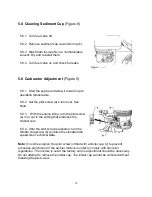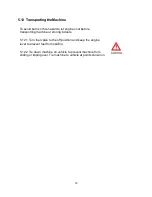
12
4.9.5 Move the throttle lever to the idle position
(a1)
.
Note: The operator present lever must be fully engaged to start and run trowel. If the
lever is not engaged, engine will not run.
4.9.6 Engage the operator present lever
(e)
, if so equipped, stand to the side of the
machine and pull the starter rope
(j)
.
Do not place foot on the ring guard when starting the engine, as severe injury can occur
if foot slips through the ring guard as the blades start to spin.
Note: If the engine oil is low, the engine will not start. If engine does not start, check the
oil level and add oil as needed.
4.9.7 Open choke as engine warms
(i2)
.
4.9.8 Open throttle
(a2)
to operate trowel. Adjust blade RPM with throttle speed to suit
conditions.
4.10 To Stop
4.10.1 Reduce engine RPM to idle by moving the throttle lever to slow position
(a1)
.
4.10.2 Place the Run/Stop Switch to the “
O
” (stop) position
(b2)
or release operator
present lever
(e)
.
4.10.3 Turn engine switch to “OFF”
(h2)
.
4.10.4 Close fuel valve by moving lever to the left
(g2)
.
4.11 Operation
Choose correct blade type and attach blades to trowel arms. Do not mix float or finish
blades with combination blades.
Note: When operating on soft concrete, do not let trowel stand in one spot too long.
Always lift trowel from slab when operation is complete.
Note: “Left” and “Right” references are made from the operator's position.
4.11.1 Adjust handle height to suit operator. See
Installing and Adjusting Handles.
4.11.2 Start engine and engage blades by increasing engine speed. Set speed with
throttle control on handle bar to appropriate speed for job conditions.
4.11.3 To move trowel forward twist handle clockwise
(a)
.
4.11.4 To move backward twist handle counterclockwise
(b)
.
4.11.5 To move to the left lift up slightly on the handle
(c)
.
4.11.6 To move to the right press down slightly on the handle
(d)
.
4.11.7 Clean trowel after each use to remove concrete splatter.
























